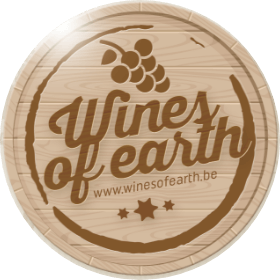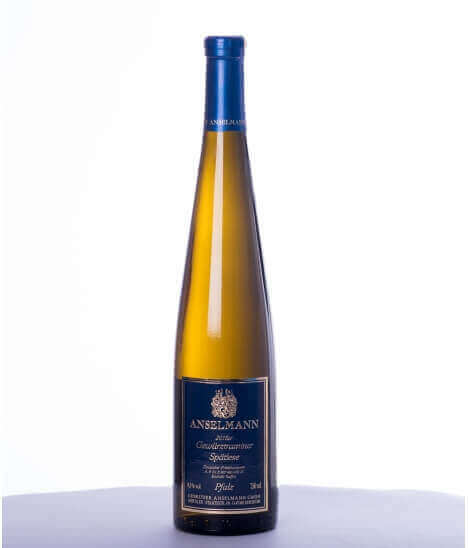Vin blanc allemand liquoreux - Pfalz - Anselmann - Cuvée Gewurztraminer Spätlese - Vendanges tardives
DEANSE14W01
This Gewürztraminer Spätlese will be a sure bet for fans of sweet wines . Produced from late harvests in the Palatinate (Pfalz), this sweet German white wine from Weingut Anselmann displays an intense bouquet of rose, mango, lychee, passion fruit and apricot, supported by a freshness that avoids any heaviness. Nothing to envy from the best Alsatian late harvests!
-
 Robe
Ce vin blanc allemand liquoreux dévoile une magnifique robe or brillant, limpide, avec beaucoup d’éclat.
Robe
Ce vin blanc allemand liquoreux dévoile une magnifique robe or brillant, limpide, avec beaucoup d’éclat.
-
 Nez
Bouquet intense et expressif. Notes florales dominantes de rose fraîche, suivies de fruits exotiques : mangue mûre, litchi, maracuja et abricot bien juteux.
Nez
Bouquet intense et expressif. Notes florales dominantes de rose fraîche, suivies de fruits exotiques : mangue mûre, litchi, maracuja et abricot bien juteux.
-
 Bouche
Attaque ronde, veloutée et aromatique. Le sucre est bien présent, mais porté par une acidité parfaitement dosée qui assure fraîcheur et équilibre. Finale longue, fruitée, persistante, sans lourdeur.
Bouche
Attaque ronde, veloutée et aromatique. Le sucre est bien présent, mais porté par une acidité parfaitement dosée qui assure fraîcheur et équilibre. Finale longue, fruitée, persistante, sans lourdeur.
-
 Température de service
À servir entre 8 et 12°C
Température de service
À servir entre 8 et 12°C
-
 Idées mets / vins
Superbe avec un foie gras de canard ou d’oie, des fromages persillés (Roquefort, Gorgonzola), des desserts fruités type Apfelkuchen ou Stollen. Excellent également à l’apéritif.
Idées mets / vins
Superbe avec un foie gras de canard ou d’oie, des fromages persillés (Roquefort, Gorgonzola), des desserts fruités type Apfelkuchen ou Stollen. Excellent également à l’apéritif.
-
Satisfait ou remboursé
-
Paiement sécurisé
-
Livraison gratuite dès 100 € d'achat
Fiche technique
| Type | Blanc |
| Millesime | 2024 |
| Garde | Consommation plus de 5 ans |
| Volume bouteille | 0.75L |
En savoir plus
About the German Anselmann Estate
The Anselmann family can be traced back to 1126 in ancient archives. Since then, they have always been connected in one way or another to the vine. But it was in 1959 that the winemaking adventure really began: Werner Anselmann , father of the current generation, decided to vinify and bottle his own vintages.
The estate is located in Edesheim , in the southern Palatinate (Pfalz) , very close to the French border. The location is very interesting: between Kaiserslautern , Karlsruhe and Heidelberg , at the junction between the wooded slopes of the Pfälzerwald (German extension of the Vosges) and the fertile plains of the Rhine.
Today, Anselmann is one of the largest family farms in the country . Managed by Gerd, Ruth and Ralf Anselmann , the estate cultivates 80 hectares of its own , and vinifies an additional 50 hectares . This is a real in-depth work on the terroirs, carried out by plot , in the manner of the Burgundian climates, to enhance each expression of the soil. Among the emblematic places they cultivate, we find in particular:
- Edesheimer Rosengarten
- Edesheimer Mandelhang
- Edesheimer Schloß
- Edesheimer Forst
- Edesheimer Ordensgut
- Edenkobener Heidegarten
- Edenkobener Kirchberg
- Rhodter Klosterpfad
- Flemlinger Herrenbuckel
- Flemlinger Vogelsprung
- Flemlinger Bischofskreuz
- Arzheimer Seligmacher
Ralf Anselmann , an agricultural engineer who graduated from Stuttgart-Hohenheim, is the main person responsible for the development and innovation of the estate. He introduced Sauvignon Blanc to the region, which is now perfectly acclimatized. He is also interested in resistant grape varieties , such as Pinot Madeleine , in response to climate change.
The vineyard is particularly eclectic: nearly 40 grape varieties are cultivated , with a large proportion of whites ( 63% ), followed by reds ( 36% ) and a small number of rosés. There are both local varieties from the Palatinate and grape varieties from elsewhere, such as Tempranillo and Cabernet Sauvignon .
Since their first gold medal at Vinitaly in 1994 , Anselmann wines have been accumulating distinctions in major competitions. In short, a sure value.
Brief presentation of the Pfalz vineyards
The Pfalz — or Palatinate in English — is one of the oldest wine-growing regions in Germany. The history of wine here dates back to the 1st century , that is, to Roman times. Located in Rhineland-Palatinate , this region continues to play a leading role in German viticulture today.
With almost 229 km² of planted area , the vineyards cover approximately 5% of the regional territory . To the west, it lies on the wooded slopes of the Pfälzerwald ; to the east, it opens onto the plains of the Rhine ; to the north, it borders the Rheinhessen , and to the south, it brushes the French border . There is therefore a mosaic of microclimates and terroirs favorable to a wide diversity of grape varieties.
The vineyards are organized around two large areas: the Südliche Weinstraße and the Mittelhaardt-Deutsche Weinstraße , which concentrates the majority of production. There are 144 wine-growing communities , spread between the Vorderpfalz (northeast) and the Südpfalz (southern Palatinate). Some towns such as Landau , Neustadt an der Weinstraße or Bad Dürkheim have become recognized centers of quality throughout the country.
The Pfalz relies on a dense network of producers. There are approximately 3,600 wineries , including 1,550 full-time managed estates. The network also includes 18 cooperatives , a driving force for technical and economic cooperation in the region. Each year, production reaches nearly 2.36 million hectoliters, with a clear export orientation, particularly to the United Kingdom, the United States and the Nordic countries.
Climate-wise, the Palatinate enjoys one of the mildest microclimates in Germany . There are an average of 1,700 hours of sunshine per year , with moderate rainfall of between 500 and 600 mm . Summers are hot, winters relatively mild, and the natural protection of the Pfälzerwald massif creates an almost Mediterranean atmosphere.
The vineyard produces mainly white wines (around 60% of the total volume ), from a great diversity: 78 grape varieties are authorized for whites. Riesling dominates with more than 25% of the surface area , followed by Müller-Thurgau, Grauburgunder (Pinot Gris) and Weißburgunder (Pinot Blanc). Red wines represent the remaining 40% , with 58 registered red grape varieties , the most present of which are Dornfelder, Portugieser and Spätburgunder (Pinot Noir).
Since the 1990s, Pfalz winemakers have accelerated the qualitative transition : plot selection, reduced yields, precision in vinification. The result: an offering largely focused on dry or semi-dry wines , well-defined, with clean and expressive profiles . Alongside still wines, the Palatinate region has also established itself as one of the great German terroirs for ice wines , which are now emblematic.
Vinification of this sweet German white wine
- Late harvest, harvested at full maturity to maximize the concentration of sugar and aromas.
- Gentle pressing of the grapes to preserve the aromatic finesse of the Gewürztraminer grape variety.
- Slow fermentation in temperature-controlled stainless steel vats to preserve freshness and floral expression.
- Controlled stopping of fermentation to maintain a balance between residual sugar (75.5 g/L) and acidity.
Characteristics of this late harvest Gewürztraminer
- Production region : Edesheim, Pfalz (Palatinate), Germany
- Grape variety : 100% Gewürztraminer
- Alcohol content : 9.25% vol.
- Residual sugar level : 75.5 g/L
- Acidity level : 5.6 g/L
Awards for Anselmann's Gewürztraminer Spätlese
- Mundus Vini – Summer Tasting 2024 : Gold Medal
Avis
Monsieur
Très bon vin pour accompagner les desserts (pour tous les goûts).
Henry Mathieu
Très bon gewurztraminer pour un prix sympa. Les amateurs de vin doux vont à coup sûr s'y retrouver ! A conseiller vivement.
- 2 personne(s) sur 2 ont trouvé ce commentaire utile.





